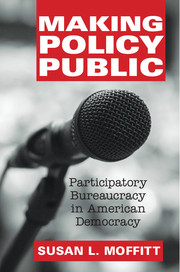Book contents
- Frontmatter
- Dedication
- Contents
- List of Figures
- List of Tables
- Preface
- Abbreviations
- 1 Portals of Democracy in American Bureaucracy
- 2 Participatory Bureaucracy in Practice
- 3 The Development of Public Committees
- 4 Making Educational Performance Public
- 5 Private Knowledge for Public Problems
- 6 Setting the Public Agenda
- 7 Deliberate Participation
- 8 The Impact of Public Advice
- 9 Participatory Bureaucracy in American Democracy
- Appendix
- Bibliography
- Index
- References
7 - Deliberate Participation
Published online by Cambridge University Press: 05 October 2014
- Frontmatter
- Dedication
- Contents
- List of Figures
- List of Tables
- Preface
- Abbreviations
- 1 Portals of Democracy in American Bureaucracy
- 2 Participatory Bureaucracy in Practice
- 3 The Development of Public Committees
- 4 Making Educational Performance Public
- 5 Private Knowledge for Public Problems
- 6 Setting the Public Agenda
- 7 Deliberate Participation
- 8 The Impact of Public Advice
- 9 Participatory Bureaucracy in American Democracy
- Appendix
- Bibliography
- Index
- References
Summary
One of the great dangers in the unregulated use of advisory committees is that special interest groups may use their membership on such bodies to promote their private concerns.
House of Representatives Report 92–1017, April 25, 1972It’s incumbent upon the members to listen carefully to the presentations from industry and to the Food and Drug Administration and neither act as advocates nor adversaries to the Agency or to the sponsors.
Statement by Chairman of the Pulmonary Allergy Drugs Advisory Committee, April 26, 1993In 2010, American federal public committees offered upward of 70,000 people a seat at agency policymaking tables, at least in an advisory capacity. Looking at the estimates of public participation on federal committees over time, depicted in Figure 7.1, represents a remarkable testament to public access to American bureaucracy.
Yet, how public are federal advisory committees in the sense of reflecting the various publics that policy affects? The vision of full group representation as a means of expressing and legitimizing democracy consistently fails to materialize in practice. Participatory processes in government agencies, such as public committees, are vulnerable to similar limitations. Allegations abound that industry dominance on committees is not just an artifact of the past – such as the Business Advisory Council housed in the Department of Commerce in 1933 – but a persistent problem despite Federal Advisory Committee Act provisions. Estimates suggest approximately 38 percent of advisory committee members in 1985 hailed from private industry, for instance. The danger of dominance is real.
- Type
- Chapter
- Information
- Making Policy PublicParticipatory Bureaucracy in American Democracy, pp. 170 - 203Publisher: Cambridge University PressPrint publication year: 2014



